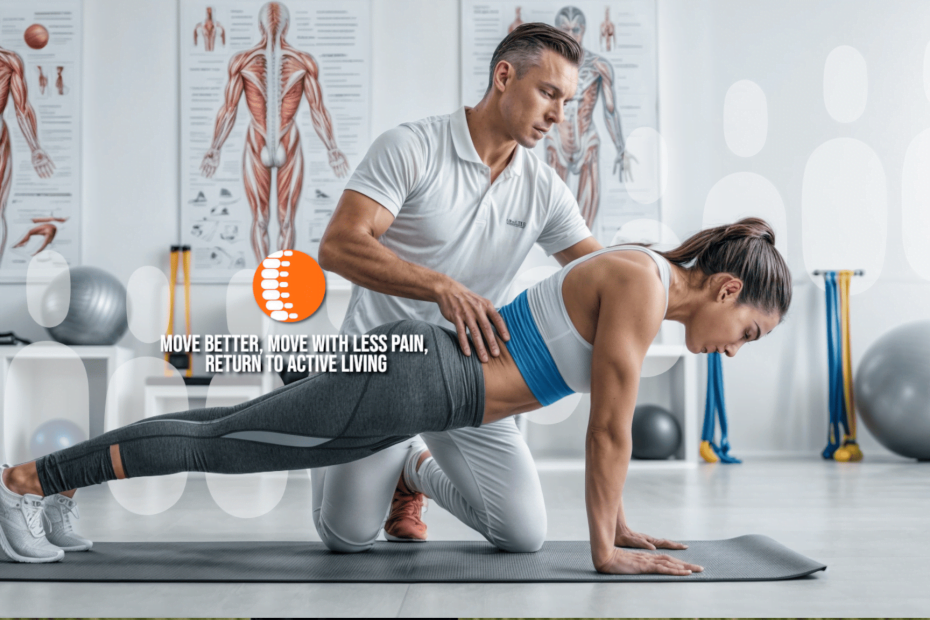Many patients spend months – even years – trying to fix their hip pain with stretching, strengthening, and treatments focused on the hip joint itself. Meanwhile, the real culprit sits just inches away in their lower back.
This phenomenon, called “referred pain,” is more common than most people realize. Understanding it is the first step toward effective recovery – and finally getting your life back.
What is Lumbar Disc Irritation with Hip Referral?
Lumbar disc irritation with hip referral occurs when a disc in your lower back (lumbar spine) becomes inflamed, herniated, or degenerated, causing compression or irritation of nearby nerve roots. These nerves are part of the lumbosacral plexus – a complex network that connects your spine to your hip and leg.
The L1-L3 nerves innervate the groin and front thigh, L4-L5 nerves control lateral hip sensation, and the sciatic nerve roots (L4-S3) influence the posterior hip. When these nerves become compressed, your brain can misinterpret the signals, creating pain that feels like it’s coming from your hip when it’s actually originating from your spine.
Recovery Timeline: What to Expect
6-12 Week Recovery Path
Weeks 1-2: Focus on reducing inflammation and nerve irritation through gentle movement and position modification.
Weeks 3-4: Restore spinal mobility and begin targeted nerve mobilization exercises.
Weeks 5-6: Build core stability and address movement patterns to prevent recurrence.
Weeks 7-12: Progressive strengthening and return to full activities with proper movement mechanics.
Evidence-Based Treatment Options
Targeted Exercise Therapy
Specific exercises that reduce nerve compression and improve nutrient flow to discs through nerve flossing (gentle movements that “glide” irritated nerves), motor control exercises for deep core activation, and directional preference techniques that centralize pain away from the hip.
Spinal Manipulation
Gentle joint adjustments that improve spinal mobility and reduce radicular symptoms by restoring normal joint mechanics, decreasing inflammatory cytokines, and triggering the release of pain-relieving endorphins.
Treatment Frequency: Typically 2-3 sessions per week for the first 2-3 weeks, then reducing frequency as symptoms improve.
Mobilization with Movement (MWM)
A technique that combines joint mobilization with active movement to improve nerve mobility, restore pain-free range of motion, and retrain proper movement patterns.
McKenzie Method
A systematic assessment and treatment approach that identifies “directional preferences” – specific movements that centralize pain away from the hip and empower patient self-management.
Key Components:
- Postural correction and ergonomic education
- Directional preference exercises
- Patient education on self-management strategies
- Progressive loading and activity modification
Your Prognosis & Recovery Outlook
Excellent Recovery Potential
85% of patients achieve significant recovery without surgery when following evidence-based treatment protocols.
72% of patients experience substantial pain reduction within 4-6 weeks of starting targeted therapy.
90% of patients who engage in early intervention (within 4 weeks) show better long-term outcomes.
Factors That Improve Your Prognosis
- Early diagnosis and treatment initiation
- Active participation in prescribed exercise programs
- Compliance with postural and ergonomic modifications
- Maintenance of regular physical activity within pain limits
- Addressing lifestyle factors that contribute to disc health
What Can Make It Worse?
- Prolonged Sitting – Increases disc pressure by 140% and compresses nerve roots
- Forward Bending – Squeezes disc nucleus posteriorly, increasing nerve compression
- Morning Stiffness Neglect – Discs hydrate overnight, making them more vulnerable to injury
- High-Impact Activities – Can aggravate nerve inflammation and delay healing
- Poor Sleep Posture – Twists lumbar spine and maintains nerve irritation
- Chronic Stress – Increases muscle tension and pain sensitivity
- Dehydration – Compromises disc nutrition and healing capacity
What Should You Change?
Workstation Ergonomics
- Chair Height – Raise seat to hip-knee level to reduce lumbar flexion
- Monitor Position – Elevate to eye level to prevent forward head posture
- Lumbar Support – Use rolled towel at belt line to maintain natural spine curve
- Frequent Breaks – Stand and move every 30-45 minutes to decompress spine
Sleep and Recovery
- Sleep Position – Side lying with pillow between knees to maintain spine alignment
- Mattress Support – Medium-firm mattress to support natural spine curves
- Morning Routine – Gentle stretching before getting out of bed
Nutrition and Hydration
- Anti-inflammatory Foods – Turmeric, omega-3 fatty acids, and colorful vegetables
- Adequate Hydration – 35ml per kg body weight daily to maintain disc health
- Magnesium Supplementation – 400mg at bedtime to reduce muscle spasms
- Vitamin D – Ensure adequate levels for bone and muscle health
Seek Immediate Medical Attention If You Experience:
While most cases of lumbar disc irritation with hip referral respond well to conservative treatment, certain symptoms require immediate medical evaluation:
- Saddle anesthesia (numbness in groin/buttocks area)
- Bowel or bladder dysfunction
- Progressive leg weakness or foot drop
- Unexplained weight loss with worsening night pain
- Fever accompanied by severe back pain
Clinical Practice Guidelines
Evidence-Based Treatment Approach
According to the North American Spine Society (NASS) and American Physical Therapy Association guidelines, the most effective treatment for lumbar radiculopathy combines manual therapy, specific exercise prescription, and patient education for optimal outcomes.
Scientific References
- Owen PJ, et al. Motor control exercise for radiculopathy. Cochrane Database Syst Rev (2020)
- Leininger BD, et al. Spinal manipulative therapy for leg pain. Spine J (2019)
- Cook C, et al. Effects of lumbar SNAGs with neurodynamics. Musculoskelet Sci Pract (2022)
- North American Spine Society. Lumbar Radiculopathy Clinical Guidelines. NASS Guidelines (2020)
- Lin I, et al. Lifestyle interventions for low back pain. Eur Spine J (2021)
- George SZ, et al. Nonpharmacologic therapies for low back pain. Ann Intern Med (2017)
- Kreiner DS, et al. An evidence-based clinical guideline for the diagnosis and treatment of lumbar disc herniation with radiculopathy. Spine J (2014)
Originally posted on July 15, 2025 @ 12:11 pm
